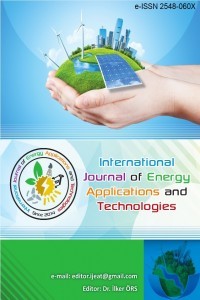Markov Chain theoretic approach to modelling industrial safety: some results from Nigeria oil and gas industry
Markov Chain theoretic approach to modelling industrial safety: some results from Nigeria oil and gas industry
the oil and gas industry. This study seeks to unravel the hidden details enwrapped in the safety data which enable the development of a model that would be effective in predicting future occurrence of industrial accidents. The purpose of this study is to spotlight the epidemiological impact of industrial accidents which claim lives, maim personnel and lower productivity through loss of man-hours. The major strategy adopted consists of the examination of a 10-year unified industrial accident recorded from 2007 to 2016 in the oil and gas sector of the Niger Delta of Nigeria. The Markov Chain model was applied to determine how workers habituate among different positions in the company before getting entrapped in any of the absorbing states. The industrial accident records are examined for embedded Markov properties, namely: stochastic regularity, absorbing behavior and the long-run distribution amongst the various states. The statistical computations were carried out with the aid of Matlab (R2017a) software. The historical Health Safety and Environment (HSE) statistical data were found to have an absorbing chain property. Thirteen (13) transition states were defined and named as; fatality, medical treatment, first aid cases, Lost time injury frequency, restricted work cases, first aid case, near miss, lost time injury, environmental incident, fire incident, unsafe acts, unsafe condition and number of attendance of clinic. The result from the study also revealed that staff makes between 17-18 habituations before being trapped in an absorbing state. Remarkably, 99% of workers in the organization had severe medical treatment cases (MTCs) as a result of work-related occupational illness and injury. The implication of the study is that the safety policy outlook of this company should be reorganized to reduce its lost workdays due to minor injury and illness.
Keywords:
Absorbing state, HSE records, Industrial accident, Markov Chain Valued diagraph,
___
- Andrea, B. and Alessandro, P. 2010. Role of Best Estimate Plus Uncertainty Methods in Major Nuclear Power Plant Modifications. Journals of Nuclear Science and Technology, 47:8, 671-68.
- Igboanugo, A.C. 2010. Markov Chain analysis of accident data: The case study of an Oil and Gas firm in the Niger Delta area of Nigeria. International Journal of Engineering Research in Africa, Vol.1: pp 29-38.
- Nikbakht, M. 2011. Hazard Identification and Accident Analysis on City Gate Station in Natural Gas Industry. Proceedings of 2011 International Conference on Industrial Engineering and Operations, pp. 3-4.
- Brameret, P. 2015. Assessment of reliability indicators from automatically generated partial Markov chains. Other. Ecolenormalesuperieure de Cachan - ENS Cachan. English. NNT: 2015DENS0032. tel-01230869.
- Okwu, M.O., Thaddeus. C., Nwaoha, O. G. 2016. Application of Markov Theoretical model in Predicting Risk Severity and Exposure Levels of Workers in the Oil and Gas sector: International Journal of Mechanical Engineering and Applications, Vol 4, (3):103- 108.
- Shaver K.G. 1970. Defensive attribution: Effects of severity and relevance on the responsibility assigned for an accident. Journal of personality and social psychology, vol. 14: 101 – 113.
- Struthers, W., Colwill, N.L., Perry, R.P. 1992. An attributional analysis of decision making in a personnel selection interview. Journal of Applied Social Psychology, vol. 22: 801 – 818.
- Hewstone, M. 1994. Collective beliefs and explanation of social events. In Hewstone M. (Ed.), causal attribution. From cognitive processes to collective beliefs, pp.205 –239.
- Salminen, S. 1997. Risk-taking, attributions, and serious accidents. Helsinki, Finland: Finish Institute of Occupational Health, pp.13-19.
- Geller, E. S. 2001. Working Safe: How to Help People Actively Care for Health and Safety. Second edition Lewis publisher Bola Raton London New York Washington D.C pg 27-31.
- Amoroso, A., and Bezzi, F. 2003. A Reactive software system to Monitor and Assess Industrial accidents. Journal of Systems Analysis Modelling Simulation, vol.43, No.5, pp.625 – 638.
- Jeong, K., Lee, D., Lee, K. & Lim H., 2007. A qualitative identification and analysis of hazards, risks and operating procedures for a decommissioning safety assessment of a nuclear research reactor. Annals of Nuclear Energy, 35, 1954-1962.
- Cappetti, N., Naddeo, A., Califano, R., & Vallone, M. 2017. Using Axiomatic Design to Identify the Elements That Affect the Evaluation of Comfort/Discomfort Perception. In Advances in Social & Occupational Ergonomics, pp. 235-248.
- Pruchnicki, S.A, Wu L.J and Belenky, G. 2011. An Exploration of the utility of Mathematical Modelling Prediction Fatigue from Sleep/ wake history and circadian phase applied in accident analysis and prevention: the crash of Comair flight 5191. Accid anal prev., 43(3)1056- 61.
- Bozena, H and Mariusz, S. 2017. A Mathematical model of Accident Event Development in the Construction industry. Technical transaction Czasopismo Techniczne civil Engineering.
- Farzad, G., Fatmeh, E., Mohammad-Reza, N., Mir, E.A. 2014. A Safety Model for Industrial Robots (Markov Chain Approach) (Case Study: Haierplast Company), J.Appl. Environ. Biol. Sci., 4(8)160-168.
- Zhang, S. 2009. Risk Analysis of Construction Projects based on Markov Chain. Published in information processing pacific conference ieexplore.iee.org.
- Cappetti, N., Naddeo, A., Califano, R., & Vallone, M. 2017. Using Axiomatic Design to Identify the Elements That Affect the Evaluation of Comfort/Discomfort Perception. In Advances in Social & Occupational Ergonomics pp. 235-248.
- Yayın Aralığı: Yılda 2 Sayı
- Başlangıç: 2014
- Yayıncı: İlker ÖRS
